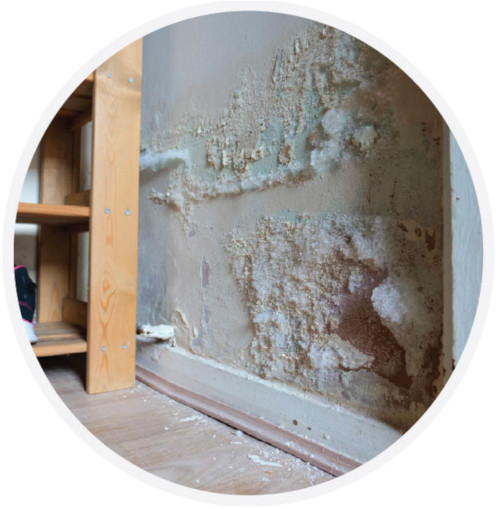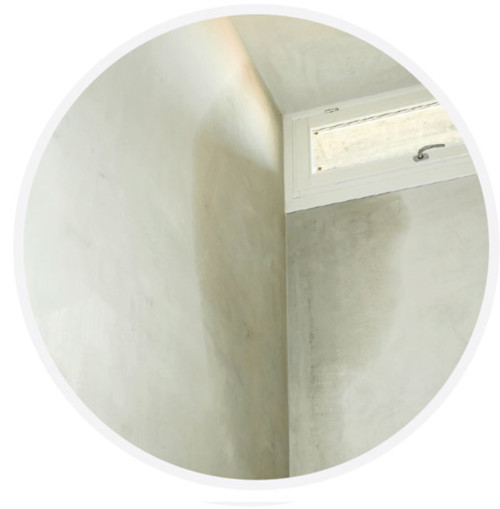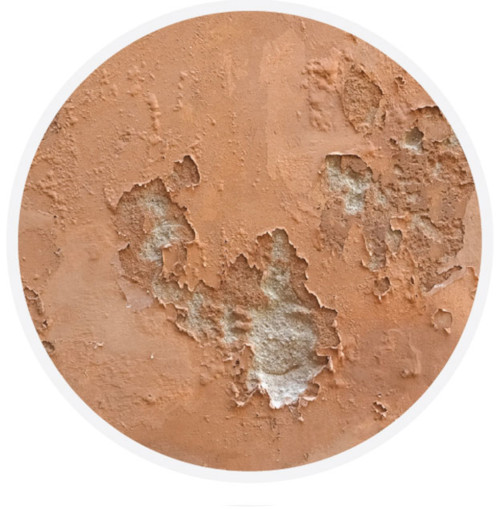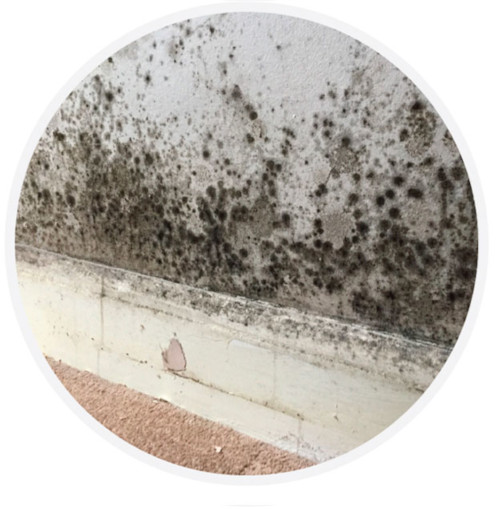Find out more about what you need to know to spot these problems, and how to tackle or report them.
- Rising damp
- Penetrating damp
- Plumbing defects
- Dampness
- Keeping your home condensation-free
- How to report your concerns
- Struggling to heat your home
Rising damp

Rising damp is caused by ground water moving up through a wall. This is usually prevented by a barrier called a Damp-Proof Course (DPC).
This can be seen as a horizontal plastic black strip low down on the outside wall (typically visible on homes built from 1960 onwards). Older homes (without the black strip) have a DPC but these may break down over time.
Rising damp only affects walls in basements or on the ground floor.
What to look out for:
- a ‘tidemark’ along the affected wall from the floor up
- blistering of paintwork or peeling wallpaper from around skirting boards and up
- damaged or crumbling skirting boards or floor boards
- white salt stains on the affected areas
Penetrating damp

Faults to the structure of the outside of the home such as missing brickwork or tiles, cracked rendering, blocked or broken guttering, gaps around windows or doors which will allow water to pass from the outside to the inside.
What to look out for:
- localised damp patches on internal walls or ceilings
- damp patch gets worse after wet weather
- a defect to the building on the outside in the location of the damp inside
Plumbing defects

Leaks from water or waste pipes, particularly in kitchens and bathrooms. Defective plumbing can cause a constant leak from water pipes, radiators or a damaged water closet. It can create an on and off leak from waste pipes where the water flow is not constant.
What to look out for:
- dampness that is not affected by the weather
- wet areas behind sinks, toilets or where household appliances are plumbed in
- damp patches on ceilings – especially if there is a kitchen or bathroom above
- damp areas that get worse when taps are run, the shower is on, or the bath is emptying
- seals around bath, showers and sinks
Dampness

It’s the most common type of damp in homes and it mainly happens in winter when walls are colder than the air inside.
Condensation occurs when moist air comes into contact with a cold surface like a window, glazed tiles or an outside wall. The water vapour in the air cools and changes to water drops. These can soak into paintwork creating the ideal conditions for black mould to grow.
What to look out for:
- water droplets on windows or walls
- patches of black mould – usually in the corner of rooms, north-facing walls and on or near windows or mirrors
- condensation dampness may be worse during the colder
- months but is not directly affected by wet or dry weather
- unpleasant ‘damp’ smell
- look throughout your home for any signs of the first 3 types of damp listed here, as they could increase the levels of moisture in the air
Keeping your home condensation-free
You can get condensation in lots of different areas of your home.
Kitchen
Keep the door closed, windows open and extractor fans on when cooking. Use lids on pans and kettles to reduce the amount of steam released.
Bathroom
Close the bathroom door when bathing or showering, and open the window andor switch on the extractor fan. Wipe down baths, showers and tiles after use. Use a mould and mildew remover spray (not bleach or soapy water) whenever black mould appears on walls, ceiling, tiles or grout.
Drying clothes
Dry your clothes outdoors whenever you can. If you need to dry clothes indoors, such as on a radiator, do so in one room with the window open and door closed. Only use tumble driers with the vent fixed to the outside.
Windows
Open windows frequently to allow air to circulate, particularly after a shower or bath or when cooking. Wipe moisture from windows and sills when it appears. Ensure that window vents remain open in the winter months. Moisture traps are a cheap way of reducing excess moisture in colder weather when you don’t want to open the window, and can be found in most home bargain shops.
Heating
If your home is too cold or hot, condensation is likely to occur, and you may increase your risk of health problems. It’s cheaper and healthier to heat cool, dry air than warm, moist air. Contact us if you need help setting and using your central heating more efficiently or need help with heating bills.
Furniture
If you can, leave a gap of at least an inch between your furniture and external walls, or put large furniture against internal walls. Don’t pile things up against walls or overfill cupboards – allow air to circulate.
Ventilation
It’s important to let damp or stale air out regularly. Use the extractor fans in kitchens and bathrooms during and after use, and keep window trickle vents open.
Heaters
Use your central heating and avoid using portable gas and paraffin heaters. They can produce up to 5 litres of moisture a day.
Draught proofing and insulation
Try to keep warmth in by fitting draught excluders on doors and windows and fitting radiator reflectors.
Removing black mould
Wipe down affected walls and window frames with a recommended fungicidal wash, or a weak water and bleach solution. Dry-clean mildewed clothes and shampoo carpets. After treatment, redecorate using a fungicidal paint or wallpaper paste to help prevent mould from recurring.
How to report your concerns
If signs of dampness in your home look like any shown in this factsheet, take action.
Report your concerns to us as soon as possible. We’ll assess the problem and work out the right solution for it.
Our phone line is open 8.30am to 5.00pm, Monday to Friday, on telephone: 01904 551550 (option 4, option 1). Or email: housing.repairs@york.gov.uk.
If the problem is severe and persists after you have done this, or if you want further advice, contact us.
If you're unhappy about how we have responded to a request for a repair, or how we have carried out a repair, please tell us first by email: haveyoursay@york.gov.uk. Your concern will be assessed and treated impartially.
Struggling to heat your home
We can look at your situation to see what help you can get towards energy costs. Telephone: 01904 552044 or email: incomeservices@york.gov.uk. Alternatively, find help with your utility bills online.
Also see


